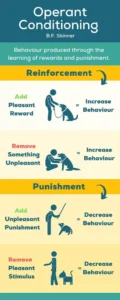Operant conditioning is a powerful and effective method for Labrador training, as it allows quick and easy reinforcement of desirable behaviors. Through operant conditioning, Labradors can learn to associate desired actions with rewards, such as treats or praise. This encourages them to repeat the behavior that was rewarded and can lead to more complex tasks and better obedience.
It enables dogs to comprehend the relationship between their actions and the consequences that follow. As a result, they can adjust their behavior based on the outcome of their actions. For example, if they are rewarded for sitting when asked, they will learn to sit more quickly and consistently when given the cue.
You can also use method of verbal praise when they display the behavior you desire, while withholding these rewards if they don’t respond correctly. You can also utilize clicker training, where you click a specific sound to indicate that your Labrador is exhibiting the desired behavior, and then provide them with a reward.
Training through Operant Conditioning
Operant conditioning is especially useful for teaching more complex behaviors such as proper leash walking, housebreaking, and socialization. With this method, you’ll need to be comfortable with giving your Labrador a variety of rewards depending on their behavior.
Clicker training can be very helpful here, as you can use the sound of the clicker to create a connection between the desired behavior and the reward.
There are 4 Principles of Operant Conditioning for Dogs. These are POSITIVE REINFORCEMENT, POSITIVE PUNISHMENT, NEGATIVE PUNISHMENT, and NEGATIVE REINFORCEMENT. We will discuss these principles one by one.
1. Positive Reinforcement
One of the most important principles is Positive Reinforcement. This is when a dog behavior results in something good, like a treat or praise, and encourages the dog to repeat that good habit. Timing is key here – if you give your Labrador their reward too late they may not connect it with the desired behavior.
2. Positive Punishment
When you get your dog to jump on you, it can be a very unpleasant experience. To discourage this behavior, one solution is to use positive punishment. This means that something bad will happen each time the dog jumps up on you. For example, if your pup jumps on you, quickly and firmly knee them in the chest. Although this may seem like a cruel thing to do, it is actually an effective punishment. The goal is not to make your dog fear you or hurt them, but rather to teach them that jumping up on people is unacceptable behavior.
3. Negative Reinforcement
A dog trainer may use a small amount of negative reinforcement to encourage certain behaviors. An example of this would be when the trainer wants their dog to sit from lying down; they pull on the leash to create resistance against the dog’s forward movement, then release it when the desired behavior is performed (the dog sitting). This teaches the dog that performing the desired behavior (in this case, sitting) will make the unpleasant thing (the pulling on the leash) go away.
4. Negative Punishment
Negative Punishment is when something good (like access to a toy or treat) is taken away following an undesired behavior. This encourages your Labrador to repeat positive behaviors in order to avoid a negative consequence.
Conclusion
Using operant conditioning with your Labrador can be an effective way to reinforce certain desirable behaviors. However, it is important to use operant conditioning with caution as it can lead to fear and anxiety in your dog if not done correctly.
It is important to ensure that the rewards you provide for positive behaviors are consistent and appropriate for the desired behavior, and that punishments are not excessive or overly harsh.

image source: (https://www.canineprinciples.com/blog/operant-conditioning-dogs-1)


